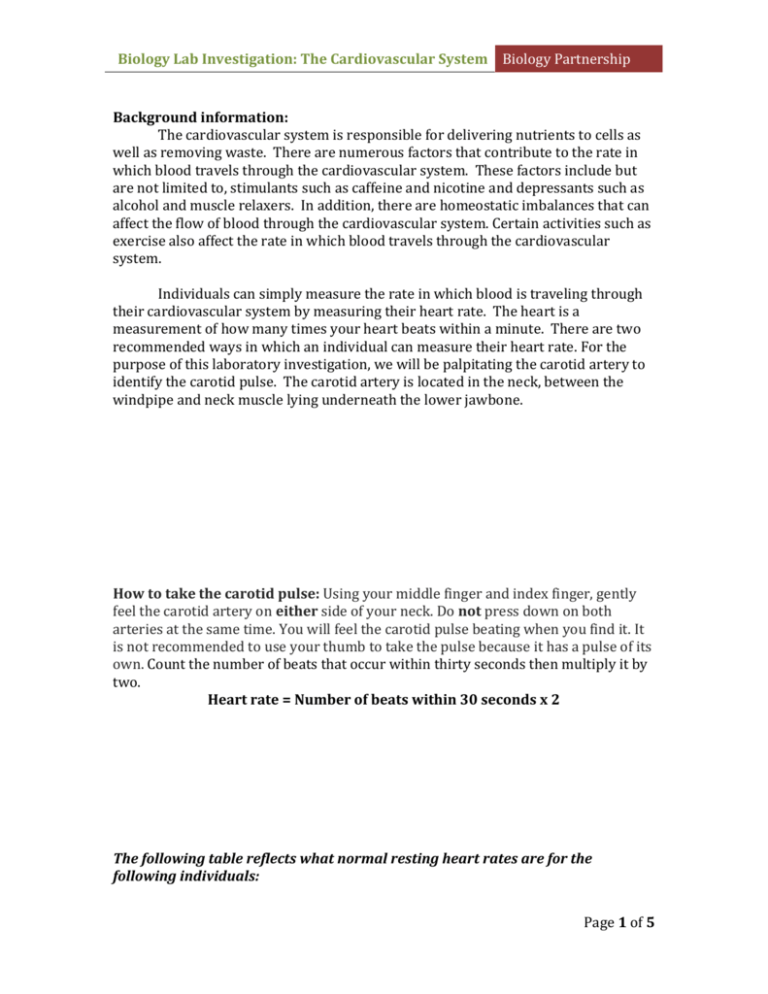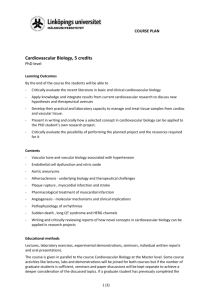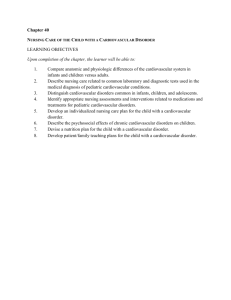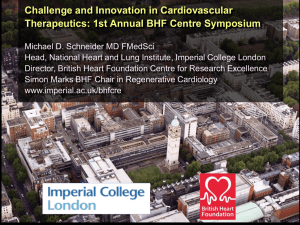Resting heart rate Age or fitness level Beats per minute (bpm)
advertisement

Biology Lab Investigation: The Cardiovascular System Biology Partnership Background information: The cardiovascular system is responsible for delivering nutrients to cells as well as removing waste. There are numerous factors that contribute to the rate in which blood travels through the cardiovascular system. These factors include but are not limited to, stimulants such as caffeine and nicotine and depressants such as alcohol and muscle relaxers. In addition, there are homeostatic imbalances that can affect the flow of blood through the cardiovascular system. Certain activities such as exercise also affect the rate in which blood travels through the cardiovascular system. Individuals can simply measure the rate in which blood is traveling through their cardiovascular system by measuring their heart rate. The heart is a measurement of how many times your heart beats within a minute. There are two recommended ways in which an individual can measure their heart rate. For the purpose of this laboratory investigation, we will be palpitating the carotid artery to identify the carotid pulse. The carotid artery is located in the neck, between the windpipe and neck muscle lying underneath the lower jawbone. How to take the carotid pulse: Using your middle finger and index finger, gently feel the carotid artery on either side of your neck. Do not press down on both arteries at the same time. You will feel the carotid pulse beating when you find it. It is not recommended to use your thumb to take the pulse because it has a pulse of its own. Count the number of beats that occur within thirty seconds then multiply it by two. Heart rate = Number of beats within 30 seconds x 2 The following table reflects what normal resting heart rates are for the following individuals: Page 1 of 5 Biology Lab Investigation: The Cardiovascular System Biology Partnership Age or fitness level Babies to age 1: Resting heart rate Beats per minute (bpm) 100-160 Children ages 1 to 10: 70-120 Children ages 11 to 17: 60-100 Adults: 60-100 Well-conditioned athletes: 40-60 Investigative question: How does exercise affect heart rate? Materials: Lab Handout Timer Safety precautions: Follow all normal lab safety precautions. Individuals with cardiovascular and pulmonary disorders should be exempt from being active participants during this lab investigation. If you are feeling dizzy, faint or experiencing shortness of breath during the activity, notify the teacher. If your heart rate measures above 160bpm, do not continue to exercise. You need to notify the teacher and rest. Procedure: You are to write a procedure for your lab investigation with the materials that you have chosen to use. o List of approved exercises: include jumping jacks, running in place, sit ups, push ups, dancing in place and jumping up and down. Must run two trials o Establish a control. o Each trial can only be a minute. Write a hypothesis, remember it must be testable. Identify the independent and dependent variables. Collect quantitative data and graph data using provided data table and graph. Form a conclusion. o Be sure to reject or except your hypothesis. o Reflect on your data to explain your conclusion. Procedure: Page 2 of 5 Biology Lab Investigation: The Cardiovascular System Biology Partnership Control: Hypothesis: Data: Data table: Graph: What were your independent and dependent variables? Page 3 of 5 Biology Lab Investigation: The Cardiovascular System Biology Partnership Conclusion: Check out questions: 1. Exercise causes heart rate to: circle one increase/decrease/ stay the same 2. When heart rate increases, the flow of blood through the cardiovascular system: a. Increases b. Decreases c. Stays the same 3. Explain why you think blood flow changes during times of exercise and rest. 4. Stimulants such as caffeine and nicotine cause heart rate to: circle one increase/ decrease / stay the same Pre-Lab Questions Page 4 of 5 Biology Lab Investigation: The Cardiovascular System Biology Partnership 1. Exercise causes heart rate to: circle one increase/decrease/ stay the same 2. When heart rate increases, the flow of blood through the cardiovascular system: a. Increases b. Decreases c. Stays the same 3. Explain why you think blood flow changes during times of exercise and rest. 4. Stimulants such as caffeine and nicotine cause heart rate to: circle one increase/ decrease / stay the same Page 5 of 5









